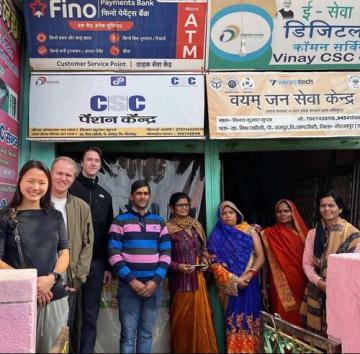Yale SOM Brings MBAs and Social Enterprises Together—With an Indian Spin

Supporting Indian social enterprises might seem like an unusual task for a team of students at Yale School of Management (SOM). But Tony Sheldon, Executive Director of the Program on Social Enterprise, Innovation, and Impact at SOM, says that it’s actually part and parcel of the school’s mission of “educating leaders for business and society.” Every year since 2008, SOM has offered Global Social Entrepreneurship/India, a practicum course in which Yale graduate students and Indian social enterprises work together to grapple with challenges the organizations face. Until 2023, the course was taught by Sheldon. Last year it was co-taught by Sheldon and Asha Ghosh, Urban Program Manager at Yale School of the Environment (YSE).
According to Sheldon, who also teaches Global Social Entrepreneurship/Brazil and Global Social Entrepreneurship/Kenya, “Active engagement with social enterprises engaged in a wide array of sectors—sustainable energy, economic development, education, healthcare, conservation, etc.—offers students the opportunity to explore how business skills and market disciplines can be harnessed to grapple with some of the pressing social and environmental challenges we all now face.” Each year students from SOM, YSE, and the Jackson School of Global Affairs apply to participate in the course. Those who are accepted are placed in mixed teams, composed of students from across the schools, and paired with a partner organization—a social enterprise in India that has a pressing management challenge it needs to tackle.
The class is unusually complex, Ghosh said, because it also requires processing applications from partner organizations and choosing only a few—four or five—from among them to participate in the class. Planning begins months in advance. “We take applications from organizations that have a defined, well-articulated problem that they feel could benefit from input from a team of students in a short period, because students will only have about four months to work with them. So the choice of partner organizations is a lot of work, because we want to make sure that they’re both going to be satisfied with what they get and that the students are going to be satisfied that they’re able to do something productive.”
Once organizations and student teams have been paired, students are expected to work independently, like consultants, with their partner organizations. They are initially trained in teamwork and communication, then tasked with conducting substantial research to understand the nature of the problems they are grappling with. This research is complemented by coursework on social entrepreneurship, impact assessment, and accomplishing change, as well as details on the Indian political and economic context.
The first half of the class comes to a close at winter break, when students travel to India for 10 days to conduct field work with their partner organizations. This can mean anything from interviews in one place to days tracking supply chains through towns and cities. At the end of this period, all of the partner organizations and student teams gather in one place for a get-together. After returning from India, the focus of the class transfers from discovery to problem-solving, which has two requirements: generating a set of deliverables, such as a report or financial model; and creating a presentation for the partner organization that synthesizes the team’s findings and makes recommendations for next steps.
While the class is short, Ghosh and Sheldon said that it has benefits for both students and partner organizations. Ghosh said, “I was really impressed with how committed students were to doing something useful. They weren’t trying to just go to India. They were trying to understand what is happening there and what they can do now and in the future to make a difference.” That commitment translates into serious recommendations for partner organizations. Sheldon recalled that one of the best collaborations he has seen was one between a team of students and an organization running a network of rural solar microgrids. “They told us afterwards that they took the students’ recommendations, incorporated these into a business plan, and then were able to raise significant funding to scale up the work.”
While there is limited formal evaluation of the long-term effects of the course on partners, both Sheldon and Ghosh said that partners’ reapplication rates spoke for themselves. Sheldon noted, “We’ve found that the best metric of the value of GSE has been that many of our partners come back again and apply to participate with a new project. Over 16 years, there are several organizations we have worked with 4, 5, even half a dozen times.” Ghosh added that the course is so popular among partner organizations that the teaching team has often had to turn down applications from returning enterprises.
As the course nears the end of its second decade, the teaching load is moving to Ghosh, an experienced development researcher and professional who was the primary teacher of the class in 2023. She is confident that the course will endure as one of Yale’s unique offerings. “Some students say that one of the main reasons they came to SOM was because of its reputation for having a focus on the social side of business, and that’s because of courses like this.”
Byline: Daevan Mangalmurti